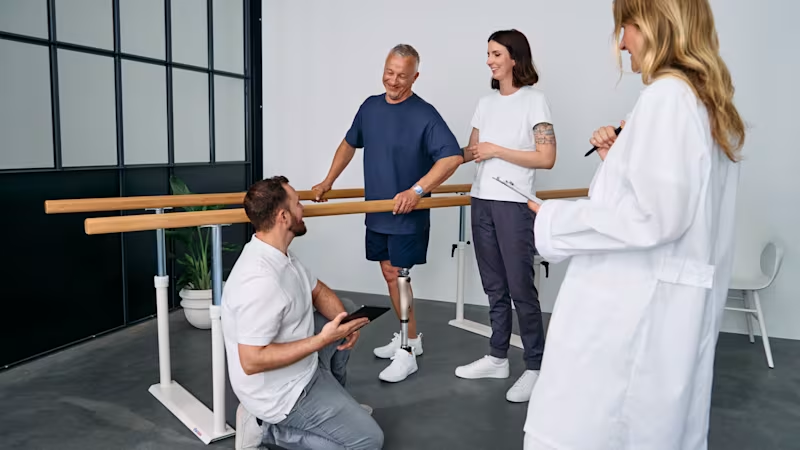Kenevo
Since its launch in 2015, the Kenevo microprocessor knee fundamentally changed prosthetics for low to moderately active amputees. This prosthetic knee was designed to provide you with a greater sense of security so you can live the life you deserve.
Since its launch in 2015, the Kenevo microprocessor knee fundamentally changed prosthetics for low to moderately active amputees. This prosthetic knee was designed to provide you with a greater sense of security so you can live the life you deserve.
Microprocessor-controlled knees have been shown to reduce the risk of falls by up to 80%1 in moderately active persons, as well as improve the indicators of fall risk, such as fear of falling.2
With key features such as Stumble Recovery Plus, supported stand-to-sit and sit-to-stand, wheelchair mode, and putting on the prosthesis while seated, it is no wonder users feel more confident and independent than ever before.
1. Kannenberg, A., Zacharias, B., & Pröbsting, E. (2014).
2. Mileusnic et al. 2017
| Product type | Microprocessor |
| Mobility grade | 1, 2 |
| Max. body weight | 150 kg |
Stability in every step

The Kenevo automatically detects when users start to sit or stand, mirroring their speed to keep them stable and in control during the transition. With no manual adjustments needed, their hands are free to use a chair or walking aid for support as desired.

The Kenevo is fine-tuned to support users with walkers, canes, or other assistive devices. Plus, with one hand movement, the wheelchair function locks the knee in a slightly outstretched position to keep the leg off the ground so users can maneuver safely.

The Kenevo is fine-tuned to support those who may need a walker, cane, or other assistive devices, so it will support you every step of the way no matter how you get there! If you sometimes use a wheelchair, the Kenevo won’t get in your way. The Kenevo’s wheelchair function enables you to keep adequate clearance between the prosthesis and the ground so you can maneuver easily.

The Kenevo was specifically designed so you can walk safely, especially on uneven terrain, down stairs and ramps, and backward. Stumble Recovery Plus is just one of the Kenevo’s safety features, which gives you the time to recover if you were to stumble. The Kenevo makes users feel safe again, allowing them to become more mobile and independent.

A new function of the Kenevo provides intuitive support while walking down ramps. As you bend the knee, the resistance increases to support and control your descent. This improves stability and can support your mobility, both indoors and out.

Exercise without compromising safety or comfort with the Kenevo’s intuitive stationary indoor bicycle function. As soon as you sit down and start pedaling, the Kenevo automatically switches functions to support your movement. Once you are finished, simply get off the stationary indoor bike and the Kenevo will automatically go back to “normal” mode so you can walk safely.

With the manual locking function, the Kenevo can be conveniently secured in the extended position by a simple tapping pattern, even when using a cosmetic solution. This offers users with low mobility additional stability in situations where increased safety is needed.

The new training feedback features provide signals for specific movement patterns during training, e.g. for stance release, stance phase flexion, load on prosthesis and many more. The users can use the feedback signals via the Cockpit app to continue prosthetic training at home and refine their movements.

Do you sometimes need to pause a moment as you are sitting down or standing up? If yes, don’t worry! The Kenevo automatically detects when you start to sit down or stand up, and will support both movements so you do not fall into or back in the chair. Since no manual adjustments of the knee are necessary, this leaves your hands free so you can use an armrest or assistive device, if needed.

Putting on the Kenevo is easier than ever thanks to complete flexion of the knee joint. Plus, it can now be charged without removing the foam cover. Just a couple of ways Kenevo users get more time — and less stress — back in their day.

The Kenevo is available for users with a body weight of up to 150 kg. This expands the application possibilities and enables even more users to benefit from the advantages of the mechatronic knee joint.
Kenevo users move forward with confidence
Product information
| Product type | Microprocessor |
| Mobility grade | 1, 2 |
| Max. body weight | 150 kg |
| Amputation level | Transfemoral amputation, Knee disarticulation, Hip disarticulation |
| User group | adults, mature adults, women, men |
| Activities | Daily use, Rehab |
Product Data
| Article number | 3C60=5 | 3C60=ST-5 |
| Mobility grade | 1, 2 | 1, 2 |
| Distal connection | Tube clamp | Tube clamp |
| Proximal connection | Pyramid | Threaded connector |
| Knee flexion angle | 124 ° | 124 ° |
| Moisture protection | IP 22 (protection against dripping water) | IP 22 (protection against dripping water) |
| Weight (without tube adapter) | 915 g | 915 g |
| Max. body weight | 150 kg | 150 kg |
| Minimum distal system height with 2R17 AXON tube adapter | 274 mm | 274 mm |
| Max. distal system height with 2R17 AXON tube adapter | 490 mm | 490 mm |
| Min. distal build height with 2R17 AXON tube adapter | 256 mm | 256 mm |
| Max. distal build height with 2R17 AXON tube adapter | 472 mm | 472 mm |

























